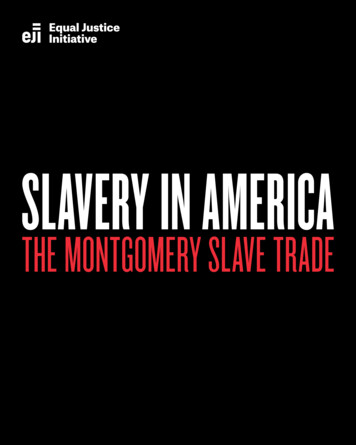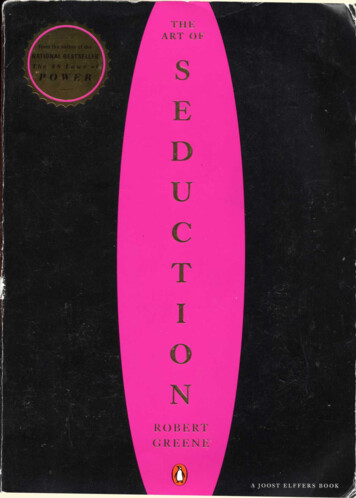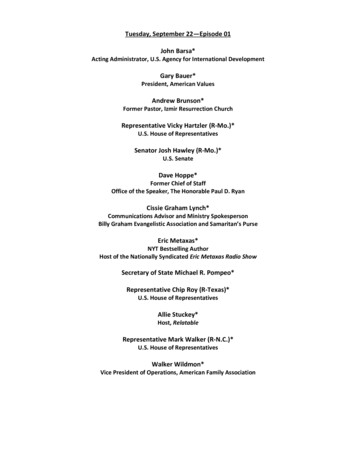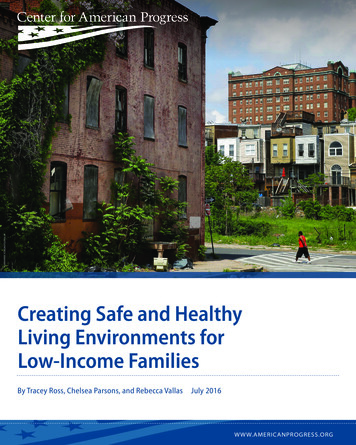
Transcription
1Slavery In America The Montgomery Slave Trade
Slavery In America The Montgomery Slave Trade2In 2013, with support from the Black HeritageCouncil, the Equal Justice Initiative erectedthree markers in downtown Montgomerydocumenting the city’s prominent role in the19th century Domestic Slave Trade.
Slavery In America The Montgomery Slave Trade4CONTENTSINTRODUCTION6SLAVERY IN AMERICA8Inventing Racial Inferiority: How American Slavery Was Different12Religion and Slavery 14The Lives and Fears of America’s Enslaved PeopleThe Domestic Slave Trade in America1523The Economics of Enslavement 24–25MONTGOMERY SLAVE TRADEMontgomery’s Particularly Brutal Slave Trading PracticesKidnapping and Enslavement of Free African AmericansSeparation of Families31383940Separated by Slavery: The Trauma of Losing Family 42–43Exploitative Local Slave Trading Practices44“To Be Sold At Auction” 44–45Sexual Exploitation of Enslaved PeopleResistance through Revolt, Escape, and Survival 48–4946
5THE POST SLAVERY EXPERIENCE50The Abolitionist Movement 52–53After Slavery: Post-Emancipation in Alabama551901 Alabama Constitution 57Reconstruction and Beyond in MontgomeryPost-War Throughout the South: Racism Through Politics and Violence6064A NATIONAL LEGACY:OUR COLLECTIVE MEMORY OFSLAVERY, WAR, AND RACE67Reviving the Confederacy in Alabama and Beyond70CONCLUSION76NotesAcknowledgments8087
Slavery In America The Montgomery Slave Trade6INTRODUCTIONBeginning in the sixteenth century, millions of African peoplewere kidnapped, enslaved, and shipped across the Atlantic to theAmericas under horrific conditions that frequently resulted instarvation and death. Nearly two million people died at sea during the agonizing journey. Over two centuries, the enslavementof black people in the United States created wealth, opportunity,and prosperity for millions of Americans. As American slaveryevolved, an elaborate and enduring mythology about the inferiority of black people was created to legitimate, perpetuate, anddefend slavery. This mythology survived slavery’s formal abolition following the Civil War.In the South, where the enslavement of black people was widelyembraced, resistance to ending slavery persisted for another century following the passage of the Thirteenth Amendment in 1865.Today, more than 150 years after the Emancipation Proclamation,very little has been done to address the legacy of slavery and itsmeaning in contemporary life. In many communities like Montgomery, Alabama — which had a prominent role in the slave tradeand was a primary site for human trafficking and facilitatingslavery — there is little understanding of the slave trade, enslavement, or the longstanding effort to sustain the racial hierarchythat slavery created. In fact, an alternative narrative has emergedin many Southern communities that celebrates the slavery era,honors slavery’s principal proponents and defenders, and refusesto acknowledge or address the problems created by the legacy ofslavery. Great progress has been made in deconstructing someof the most explicit forms of racial injustice, but questions ofracial inequality and discrimination continue to dominate social,cultural, and political life. Our history of racial injustice is notwell understood and is often avoided, creating a racial dividewhich is evident today in hundreds of formal and informal ways.
7Reconciliation with a difficult past cannot be achieved withouttruthfully confronting history and finding a way forward that isthoughtful and responsible. We invite you to join us in this effortby exploring and sharing this report on American slavery, visiting the Legacy Museum and National Memorial in Montgomery,reflecting on the bonds between historic and contemporaryracial inequality in America, and confronting the injustice in yourown community. We hope that more information fosters greaterknowledge and honest dialogue, and deepens our collective commitment to a just society. EJI believes that we have within us thecapacity to transcend our history of racial injustice. But we shallovercome only if we engage in the important and difficult workthat lies ahead.Bryan Stevenson, DirectorSlavery In America The Montgomery Slave TradeThe Equal Justice Initiative (EJI) believes that a more informedunderstanding of America’s racial history and the challengesit creates is vital to developing a healthier and more respectfullocal, state, and national identity. In April 2018, EJI opened twonew sites in Montgomery, Alabama: The National Memorialfor Peace and Justice, featuring the names of more than 4000African American victims of racial terror lynching killed between1877 and 1950; and The Legacy Museum: From Enslavementto Mass Incarceration. Built on the site of a former warehousewhere enslaved black people were imprisoned before sale, the11,000-square-foot museum sits midway between Montgomery’shistoric slave market and the main river dock and train stationthat transported tens of thousands of enslaved people at theheight of the domestic slave trade. Museum visitors encounterreplicas of slave pens that employ unique technology to bring tolife first-person accounts from enslaved people narrating the fear,heartbreak, and inhumanity of the domestic slave trade.
Slavery In America The Montgomery Slave Trade8SLAVERY IN AMERICAAn estimated 10.7 million black men,women, and children were transportedfrom West Africa and sold into slaveryin South America, Central America, orNorth America. Nearly two million moreare estimated to have perished duringthe brutal voyage.
9Slavery In AmericaThese starving people were rescued from a slave ship. Disease andstarvation killed 1.8 million enslaved people before they reached theAmericas. (The National Archives of the UK: ref. F084/1310.)The enslavement of black people in the UnitedStates lasted for more than two centuries andcreated a complex legal, economic, and socialinfrastructure that can still be seen today. Thelegacy of slavery has implications for many contemporary issues, political and social debates,and cultural norms — especially in places whereslavery or the slave trade was extensive.In the Transatlantic Slave Trade, kidnappedAfricans were “bought” by traders from WesternEurope in exchange for rum, cotton products,and weapons like guns and gunpowder.1 AsHistorian John Blassingame describes, thecaptured Africans were then shipped acrossthe Atlantic Ocean in cramped vessels underhorrific conditions:
Slavery In America The Montgomery Slave Trade10“Taken on board ship, the naked Africanswere shackled together on bare woodenboards in the hold, and packed so tightlythat they could not sit upright. During thedreaded Mid-Passage (a trip of from threeweeks to more than three months) . . . [t]hefoul and poisonous air of the hold, extremeheat, men lying for hours in their owndefecation, with blood and mucus coveringthe floor, caused a great deal of sickness.Mortality from undernourishment and disease was about 16 percent. The first fewweeks of the trip was the most traumaticexperience for the Africans. A number ofthem went insane and many became sodespondent that they gave up the will tolive. . . . Often they committed suicide, bydrowning or refusing food or medicine,rather than accept their enslavement.”2In this way, an estimated 10.7 million blackmen, women, and children were transportedfrom West Africa and sold into slavery in SouthAmerica, Central America, or North America.3Nearly two million more are estimated to haveperished during the brutal voyage.4For the millions of Africans who would faceenslavement in the United States — either atthe end of a transatlantic journey from Africa,or from birth as the descendants of Africanstransported to the country in bondage — theparticular experience of American slaverytook different forms based on region and timeperiod. Those enslaved in the northeasternstates were not as confined to agricultural workas those in the South and many spent theirlives in bondage laboring as house servants orin various positions of unpaid, skilled labor.5The less diverse Southern economy, primarilycentered around cotton and tobacco crops, gaverise to large plantations dependent on the laborof enslaved Africans, who toiled in the fieldsand ran the planters’ homes.6Slave cabin andfamily near Eufaulain Barbour County,Alabama. (Libraryof Congress, Manuscript Division.)
11Slavery In AmericaImprisoned men at Maula Prison in Malawi are forced to sleep “like the enslaved on a slave ship.” (Joao Silva/The New York Times/Redux.)In many states where slavery was prevalent, most whites rejectedemancipation and used violence, terror, and the law to disenfranchise,abuse, and marginalize African Americans for more than a century.Largely for this reason, slavery in the two regions diverged. Slavery became less efficientand less socially accepted in the Northeastduring the eighteenth century, and those statesbegan passing laws to gradually abolish slavery.In 1804, New Jersey became the last Northern state to commit to abolition. In contrast,the system of slavery remained a central andnecessary ingredient in the Southern plantation economy and cultural landscape well intothe nineteenth century.7 By 1860, in the fifteenSouthern states that still permitted slavery,nearly one in four families owned enslavedpeople.8 The South so desperately clung to theinstitution of slavery that, as the national tideturned toward abolition, eleven Southern statesseceded from the United States, formed theConfederate States of America, and sparked abloody civil war.In December 1865, just eight months after Confederate forces surrendered and the four-yearCivil War ended, the United States adopted theThirteenth Amendment abolishing slavery andinvoluntary servitude, “except as punishment forcrime.” This meant freedom for more than fourmillion enslaved black people living in the United States at the time. However, in many stateswhere slavery was prevalent, most white residents rejected emancipation and used violence,terror, and the law to disenfranchise, abuse, andmarginalize African Americans for more than acentury after emancipation.
Slavery In America The Montgomery Slave Trade12INVENTINGRACIAL INFERIORITY:HOWAMERICAN SLAVERYWASDIFFERENTThe racialized caste system of American slaverythat originated in the British colonies wasunique in many respects from the forms ofslavery that existed in other parts of the world.9In the Spanish and Portuguese colonies, forexample, slavery was a class category or formof indentured servitude — an “accident” ofindividual status that could befall anyone andcould be overcome after a completed term oflabor or assimilation into the dominant culture.10American slavery began as such a system.When the first Africans were brought to theBritish colonies in 1619 on a ship that docked inJamestown, Virginia, they held the legal statusof “servant.”11 But as the region’s economic system became increasingly dependent on forcedlabor, and as racial prejudice became moreingrained in the social culture, the institutionof American slavery developed as a permanent,hereditary status centrally tied to race.12The institution of American slaverydeveloped as a permanent, hereditarystatus centrally tied to race.Many enslaved and orphaned children were unprotected duringthe turmoil of the Civil War. (George Eastman House, InternationalMuseum of Photography and Film.)Over the next two centuries, the system ofAmerican slavery grew from and reinforcedracial prejudice.13 Advocates of slavery arguedthat science and religion proved white racialsuperiority: under this view, white people weresmart, hard-working, and more intellectuallyand morally evolved, while black people weredumb, lazy, child-like, and in need of guidanceand supervision. In 1857, for example, Mississippi Governor William McWillie denounced
Though the reality of American slavery was often brutal, barbaric,and violent, the myth of black people’s racial inferiority developed andpersisted as a common justification for the system’s continuation.anti-slavery critics and insisted:“[T]he institution of slavery, per se, is as justifiable as the relation of husband and wife,parent and child, or any other civil institution of the State, and is most necessary tothe well-being of the negro, being the onlyform of government or pupilage which canraise him from barbarism, or make himuseful to himself or others; and I have nodoubt but that the institution, thus far inour country, has resulted in the happinessand elevation of both races; that is, the negro and the white man. In no period of theworld’s history have three millions of thenegro race been so elevated in the scale ofbeing, or so much civilized or Christianized,as those in the United States, as slaves.They are better clothed, better fed, betterhoused, and more cared for in sickness andin health, than has ever fallen to the lot ofany similar number of the negro race inany age or nation; and as a Christian people, I feel that it is the duty of the South tokeep them in their present position, at anycost and at every peril, even independentlyof the questions of interest and security.”14This perspective defended black people’s lifelong and nearly inescapable enslavement in theUnited States as justified and necessary. Whiteslave holders were performing an act of kindness, advocates claimed, by exposing the blackpeople they held as human property to discipline,hard work, and morality. Though the reality ofAmerican slavery was often brutal, barbaric, andviolent, the myth of black people’s racial inferiority developed and persisted as a commonjustification for the system’s continuation. Thisremained true throughout the Civil War, the 1863Emancipation Proclamation, and the adoption ofthe Thirteenth Amendment in 1865.Indeed, ending slavery was not enough to overcome the harmful ideas created to defend it.15“Freeing” the nation’s masses of enslaved blackpeople without undertaking the work to deconstruct the narrative of inferiority doomed thosefreedmen and -women and their descendants toa fate of subordinate, second-class citizenship.In the place of slavery, the commitment to racialhierarchy was expressed in many new forms,including lynching and other methods of racialterrorism; segregation and “Jim Crow”; andunprecedented rates of mass incarceration.13Slavery In America“Contrabands” were enslavedpeople who escaped from plantations and sought protectionfrom Union forces during theCivil War. These men escapedfrom plantations in SouthCarolina in 1862. (Collection ofthe New-York Historical Society,neg # 44751.)
Slavery In America The Montgomery Slave Trade14RELIGION AND SLAVERYAs early as the 10th century,biblical scripture was used tosupport the claim that Africanswere a cursed people fit onlyfor slavery.16 As scholar IbramX. Kendi has documented,religion became a more common justification for slaveryas national economies grewdependent on maintaining thesystem of bondage. To protectslavery, the American coloniesand later the United States embraced religious teachings thatendorsed ideas of black inferiority, approved the inhumanityof chattel slavery, and promisedreward to black people whosubmitted to enslavement.When slavery began in NorthAmerica in the 17th century,the lands that would becomethe United States were colonies held by the British, andBritish law forbade the enslavement of Christians. MostAfricans then practiced Islamor African folk religions — andas Christian missionaries setout to convert enslaved Africans in the colonies, Britishslave owners worried theywould lose their enslavedproperty if Africans were nolonger seen as non-Christian heathens. This fear wasrealized in 1656 when Elizabeth Key, the daughter of anenslaved black woman and awhite Englishman, successfully sued for her and her child’sfreedom by arguing that herChristianity should shield herfrom enslavement. If slaverywas to survive, religious teachings would have to adapt.17In 1664-1665, a British minister named Richard Baxterpublished a treatise encouraging slave owners to convertthe enslaved to Christianityand arguing that slavery wasa righteous institution that allowed for the saving of Africansouls — without requiring theirfreedom.18 He told his Puritanreaders that slavery was beneficial to African people, andpaved the way for white peopleto buy, sell, and abuse Africanpeople while maintaining aChristian identity. Compatiblelaws soon followed.In 1667, the colony of Virginiadeclared that Christian baptism did not exempt enslavedblack people from bondage,and New York and Marylandsoon did the same.19 Theselaws allowed white evangelicals to share Christianity withblack people without the risk offorced emancipation, and laterlaws further restricted blackChristians’ religious practiceand barred interracial worshipservices. After the colonieswon independence and established the United Statesof America, these laws onlystrengthened.As the abolitionist movementgrew in the North, someopenly challenged the church’stolerance of slavery — butSouthern churches, largelydependent on the support ofwhite slave owners, almostnever questioned the moralityof owning human beings.20
15Enslaved people hadto fear brutal abuseand mistreatment onmany plantations inthe South. (Donatedby Corbis.)In the decades leading up to the Civil War,confronted with abolitionists’ moral outrageand growing political pressure, Southern slaveowners defended slavery as a benevolent system that benefitted enslaved black people.21Even today, some continue to echo those claimsin attempts to justify more than two centuriesof human bondage, forced labor, and abuse.22Records from the era paint a much differentpicture, revealing American slavery as a systemthat was always dehumanizing and barbaric,and often bloody, brutal, and violent.As an institution, slavery deprived the enslavedof any legal rights or autonomy and grantedthe slave owner complete power over the blackmen, women, and children legally recognizedas his property. Structurally, this weakenedenslaved people’s claims to even the most basicsocial bond: the family. The enslaved could notSlavery deprived the enslaved of anylegal rights or autonomy and granted theslave owner complete power over theblack men, women, and children legallyrecognized as his property.legally marry, needed an owner’s permission toenter into non-legal marriages, and could beforced to marry a partner chosen by the slaveowner. Once married, husbands and wives hadno ability to protect themselves from being soldaway from each other, and if “owned” by different masters, were often forced to reside ondifferent plantations. Parents could do nothingwhen their young children were sold away,23 andenslaved families were regularly and easily separated at an owner’s or auctioneer’s whim, neverto see each other again.24Slavery In AmericaTHE LIVES AND FEARS OFAMERICA’S ENSLAVED PEOPLE
Slavery In America The Montgomery Slave Trade16“White men and women justified this cruelty byclaiming black people did not have emotionalties to each other. “It is frequently remarkedby Southerners, in palliation of the cruelty ofseparating relatives,” observed one visitor to theSouth in the 1850s, “that the affection of negroes for one another are very slight. I have beentold by more than one lady that she was sureher nurse did not have half the affection for herown children that she did for her mistress’s.”25In a first-hand account published by the American Anti-Slavery Society in 1839, a Kentuckywoman told the story of two young black men,Ned and John, who were frequently severelywhipped by their master as punishment for“staying a little over the time with their wives”living on different plantations nearby: “Mr. Longwould tie them up by the wrist, so high that theirtoes would just touch the ground, and then witha cow-hide lay the lash upon the naked back,until he was exhausted, when he would sit downand rest. As soon as he had rested sufficiently,he would ply the cow-hide again, thus he wouldcontinue until the whole back of the poor victimwas lacerated into one uniform coat of blood.”26Both men died young, from illness brought onby this abuse.In addition to the labor exploitation inherent toslavery, slave owners had the power to sexuallyexploit the enslaved people they held, bothmale27 and female. Sexual abuse of enslavedblack men included being forced to have sexwith enslaved women against their will and infront of a white audience. In 1787, two whiteslave owners in Maryland forced an enslavedblack man, at gunpoint, to rape a free blackwoman; when the act was done, one of thewhite men likened the act to breeding horses.28To be a man, and not to be a man—a father without authority—a husbandand no protector—is the darkest of fates. Such was the condition of myfather, and such is the condition of every slave throughout the United States:he owns nothing, he can claim nothing. His wife is not his: his children arenot his; they can be taken from him, and sold at any minute, as far awayfrom each other as the human fleshmonger may see fit to carry them. Slavesare recognised as property by the law, and can own nothing except by theconsent of their masters. A slave's wife or daughter may be insulted beforehis eyes with impunity. He himself may be called on to torture them, anddare not refuse. To raise his hand in their defence is death by the law. Hemust bear all things and resist nothing. If he leaves his master's premises atany time without a written permit, he is liable to be flogged. Yet, it is said byslave holders and their apologists, that we are happy and contented.29John S. Jacobs, 1815-1875, was enslaved in North Carolina as a child and escaped to freedom in adulthood.
17Slavery In America The Montgomery Slave TradeAn enslaved man,Private Gordon, wasbeaten so frequentlythat the multiplewhippings left graphicscars depicted in this1863 photograph.(Donated by Corbis.)
MR.LONGWOULDTIETHEMUPBYTH“THAT THEIR TOES WOULD JTHEN WITH A COW-HIDE LAY THE LASHUNTIL HE WAS EXHAUSTED, WHEN HEAS SOON AS HE HAD RESTED SUFFICIEAGAIN,THUS HEBACK OF THE POOR VICTIM WCOATOFSlavery In America The Montgomery Slave Trade18
Slavery In America The Montgomery Slave TradeHE WRIST, SO HIGHJUST TOUCH THE GROUND, ANDHUPON THE NAKED BACK,E WOULD SIT DOWN AND REST.IENTLY, HE WOULD PLY THE COW-HIDEE WOULD CONTINUE UNTIL THE WHOLEWAS LACERATED INTO ONE UNIFORMBLOOD.1926
Slavery In America The Montgomery Slave Trade20In its most prevalent form — the rape of enslavedblack women by white slave owners — sexual abuse often resulted in the birth of biracialchildren who were also enslaved. As property,enslaved black women were not protected bythe law and had no refuge from sexual violence.In 1855, a 19-year-old enslaved black womannamed Celia stood trial for killing Robert Newsom. A white slave owner, Newsom had purchased Celia five years before and raped herregularly and repeatedly ever since — resultingin the birth of one child.30 After repeated entreaties to the slave owner’s daughter led nowhere, Celia took action. When Newsom cameto her cabin seeking sex on the night of June23, 1855, Celia told authorities, she clubbed himover the head twice with a large stick, killinghim.31 The court concluded an enslaved blackwoman had no right to defend herself againstsexual attack, and an all-male, all-white juryconvicted Celia of murder.32 Sentenced todeath, she was hanged on December 21, 1855.33Finally, enslaved people frequently sufferedextreme physical violence as punishment foror warning against transgressions like runningaway, failing to complete assigned tasks, visiting a spouse living on another plantation, learning to read, arguing with white people, workingtoo slowly, possessing anti-slavery materials, ortrying to prevent the sale of their relatives.34Because slave owners faced no formal prohibition against maiming or killing the enslaved,an enslaved person’s life had no legal protection; for some slave owners, this led to recklessdisregard for life and horrific levels of cruelty.In Charleston, South Carolina, in 1828, a slaveholder flogged an enslaved thirteen-year-oldgirl as punishment, then left her on a table ina locked room with her feet shackled together.When he returned, she had fallen from the tableand died. The slave holder faced no consequence; under local law, “the slave was [his]property, and if he chose to suffer the loss, noone else had anything to do with it.”35 When anenslaved black man named Moses Roper ranaway from bondage in North Carolina, his ownerwhipped him with 100-200 lashes; covered hishead in tar and lit it afire. When Moses escapedfrom leg irons, his owner had the nails of hisfingers and toes beaten off.36Enslaved people frequently sufferedextreme physical violence aspunishment for or warning againsttransgressions like running away, failingto complete assigned tasks, visitinga spouse living on another plantation,learning to read, arguing with whites,working too slowly, possessing antislavery materials, or trying to preventthe sale of their relatives.Even very young children were not safe frombrutal abuse. In a letter to a cousin, a slaveholding white woman described the killing of a 12-18month old child. “Gross has killed Sook’s youngest child,” she wrote. “[B]ecause it would not doits work to please him he first whipt it and thenheld its head in the [creek] branch to make ithush crying.”37In May 1857, after a white family in Louisville,Kentucky, was murdered and their home de-
21As illustrated by this and many similar accounts,enslaved black people faced the constant threatof attack, abuse, and murder under the systemof American slavery, which devalued their lives,ignored their human dignity, and offered no protection under the law. Long after slavery ended,racialized attacks and extra-judicial lynchingslike these continued, fueled by the same mythof racial inferiority previously used to justifyenslavement.Enslaved black people faced the constant threat of attack, abuse,and murder under the system of American slavery, which devaluedtheir lives, ignored their human dignity, and offered no protectionunder the law.Randolph Linsly Simpson African-American Collection, Yale Collection of American Literature, Beinecke Rare Book and Manuscript Library.Slavery In Americastroyed by fire, four enslaved black men wereaccused of the crime and stood trial. After anall-white jury found the men innocent of thecharges, an enraged mob of local white menarmed with a cannon attacked the jail and overtook the building. Facing the threat of death atthe hands of the bloodthirsty mob, one of thefour enslaved men cut his own throat in terror;the mob beat, stabbed, and hanged the otherthree black men to death.38
Slavery In America The Montgomery Slave Trade22“The Poor Slave’s Own SongFarewell, ye children of the Lord,To you I am bound in the cords of love.We are torn away to Georgia,Come and go along with me.Go and sound the jubilee, &c.To see the wives and husbands part,The children scream, they grieve my heart;We are sold to Louisiana,Come and go along with me.Go and sound, &c.Oh! Lord, when shall slavery cease,And these poor souls enjoy their peace?Lord, break the slavish power!Come, go along with me.Go and, sound, &c.Oh! Lord, we are going to a distant land,To be starved and worked both night and day;O, may the Lord go with us;Come and go along with me.Go and sound, &c.39”
23In the late eighteenth and early nineteenth centuries, the United States acquired great swathsof land to the south of the original thirteen colonies. White settlers in search of cheap, fertileland began to move to this area from statesin the Upper South, including North Carolina,Tennessee, Virginia, and Kentucky. These settlers brought with them enslaved black peopleto work the land and care for their homes.40By the 1790s, the invention of the cotton ginallowed for increased production and the risingprice of cotton created incentives for settlers toexpand their plantations — and their supply ofenslaved workers. In territories that would laterbecome the Lower South states of Alabama,Louisiana, Mississippi, and Florida, the demandfor enslaved black people skyrocketed.41After Congress outlawed the TransatlanticSlave Trade beginning in 1808,42 growingdemand for enslaved black laborers had to relyon natural reproduction in the local enslavedpopulation, or the sale of enslaved people fromone state to another. Over the next half century,this “domestic slave trade” became ubiquitousacross the South and central to the debate overwhether to abolish slavery.An estimated one million enslavedpeople were forcibly transferred fromthe Upper South to the Lower Southbetween 1810 and 1860.43 By the timeAlabama became a state in 1819, thedomestic slave trade was booming.Over the next forty years, the enslavedpopulation in Alabama increased from40,000 to 435,000.44The most prominent reason for the forcedtransfer of so many enslaved people from theUpper to the Lower South was the economy.Due to the booming cotton industry, enslavedblack people were worth more in the LowerSouth than anywhere else in the country — andthey were also a more secure investment in theLower South, where they had less chance to escape to freedom in the North.45 Forced abolitionwas less of a threat in the Lower South where,in comparison to the Upper South, there wasmuch less political will or popular support forcreating legal prohibitions on slavery.Slavery In AmericaTHE DOMESTIC SLAVE TRADEIN AMERICA
THE ECONOMICS OF ENSLAVEMENTBeyond its benefit to Southernplantation owners, Americanslavery was a major engine ofprosperity throughout the United States and worldwide. Thelabor of enslaved black peoplein the United States fueledexplosive economic growth andwealth accumulation duringthe 19th century, particularlywithin the vast cotton andtextile trades. Many Northernbusinesses and families madewealthy in this e
gomery, Alabama — which had a prominent role in the slave trade and was a primary site for human trafficking and facilitating slavery — there is little understanding of the slave trade, enslave-ment, or the longstanding effort to sustain the racial hierarchy that slavery created. In fact, an alternative narrative has emerged










